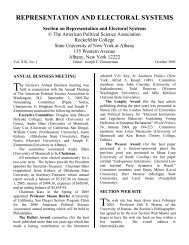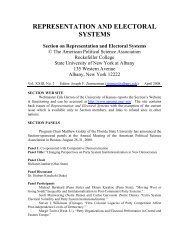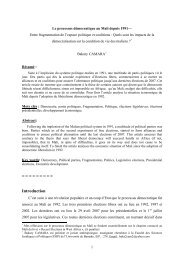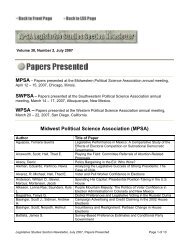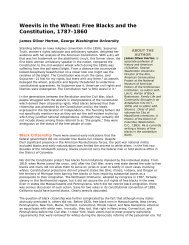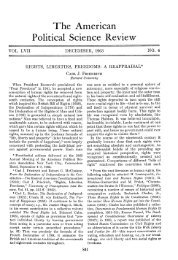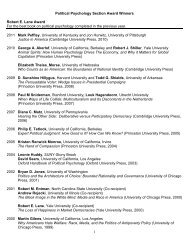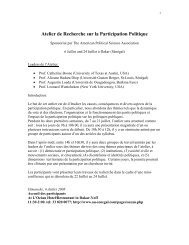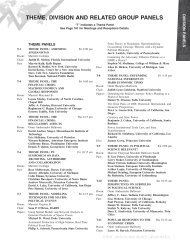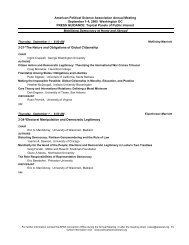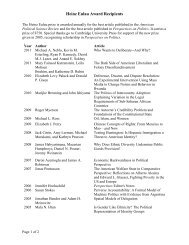The Art of Political Science: Spatial Diagrams as Iconic and Revelatory
The Art of Political Science: Spatial Diagrams as Iconic and Revelatory
The Art of Political Science: Spatial Diagrams as Iconic and Revelatory
You also want an ePaper? Increase the reach of your titles
YUMPU automatically turns print PDFs into web optimized ePapers that Google loves.
APSA Presidential Address |<br />
<strong>The</strong> <strong>Art</strong> <strong>of</strong> <strong>Political</strong> <strong>Science</strong><br />
<strong>Political</strong> Cleavages <strong>and</strong> <strong>Political</strong><br />
Realignments<br />
Let’s start with the concept <strong>of</strong> political cleavages, a concept<br />
which appeared in the literature sometime around<br />
the 1890s, initially <strong>as</strong> a way to describe a split in some<br />
political groups. 24 In the next few decades, political commentators<br />
moved on to describe political cleavages in terms<br />
<strong>of</strong> oppositions between specific socio-demographic<br />
characteristics—the town versus the country, the worker<br />
versus the owner, Protestants versus Catholics—or in terms<br />
<strong>of</strong> specific issues—such <strong>as</strong> socialism versus capitalism, temperance<br />
versus “wet,” free-silver versus the gold st<strong>and</strong>ard,<br />
or protective tariff versus free trade.<br />
<strong>The</strong> term “cleavage” w<strong>as</strong> borrowed from geology, where<br />
it w<strong>as</strong> first used in the early nineteenth century to describe<br />
features <strong>of</strong> rocks, especially crystals <strong>and</strong> their lines <strong>of</strong> cleavage.<br />
In his Geological Observations on South America published<br />
in 1846, Charles Darwin noted: “by the term<br />
cleavage I imply those planes <strong>of</strong> division which render a<br />
rock, appearing to the eye quite or nearly homogeneous,<br />
fissile.” 25 That a solidly appearing rock might cleave along<br />
invisible lines suggests an important lesson for political<br />
scientists who know that fissures sometimes suddenly<br />
appear in societies creating factions, discord, <strong>and</strong> even<br />
civil war. Moreover, the mechanism by which this occurs<br />
for rocks hints at a way that it might occur in societies.<br />
According to Darwin, “the planes <strong>of</strong> cleavage . . . are intimately<br />
connected with the planes <strong>of</strong> different tension, to<br />
which the area w<strong>as</strong> long subjected.” 26 Lines <strong>of</strong> cleavage, it<br />
turns out, result from the re-crystallization <strong>of</strong> materials<br />
that are under great pressure. 27 Similarly, it seems re<strong>as</strong>onable<br />
to suppose that lines <strong>of</strong> cleavage in societies might<br />
have something to do with the pressures socio-economic<br />
change, events, <strong>and</strong> political movements.<br />
<strong>The</strong> concept <strong>of</strong> geological cleavages, therefore, provides<br />
a useful metaphor for political science by explicitly raising<br />
a number <strong>of</strong> questions about the nature <strong>of</strong> factions.<br />
—Can politics be thought <strong>of</strong> <strong>as</strong> groups <strong>of</strong> people who<br />
can be lined up according to characteristics which<br />
produce lines <strong>of</strong> cleavage between them?<br />
—What are those characteristics?<br />
—Do those characteristics have a historical dimension<br />
<strong>and</strong> are there forces, perhaps affected by history, which<br />
determine the planes <strong>of</strong> cleavage?<br />
Although the cleavage concept does not identify what<br />
the relevant characteristics or relevant forces are, it does<br />
suggest that we should look for them.<br />
Voting reports <strong>and</strong> census data broken down by county<br />
enabled Stuart Rice, in his path-breaking 1928 book Quantitative<br />
Methods in Politics, to look for cleavages. He defined<br />
them <strong>as</strong> situations where the voting support for a c<strong>and</strong>idate<br />
differed significantly along some socio-demographic<br />
characteristic, such <strong>as</strong> geographic location within a state<br />
demarcated by wheat-growing versus corn-growing regions,<br />
or by town versus rural are<strong>as</strong>, for examples. 28 He referred<br />
to these <strong>as</strong> “lines <strong>of</strong> cleavage” <strong>and</strong> noted that “theoretically<br />
the electorate might be divided up in a well-nigh infinite<br />
variety <strong>of</strong> ways.” 29 Although Rice identifies cleavages, he<br />
describes their distinctive features superficially, <strong>and</strong> he<br />
does not explain why they arise, whether their number<br />
is limited in any way, or how they operate. 30 His approach<br />
is much like noticing that rocks have lots <strong>of</strong> lines that<br />
go across them <strong>and</strong> cataloging all <strong>of</strong> them without<br />
differentiation.<br />
In 1935, Peter Odegard provided a theory for cleavages<br />
by arguing that they are the result <strong>of</strong> conflicting group<br />
pressures b<strong>as</strong>ed upon historically determined sectional, economic,<br />
<strong>and</strong> ethnic interests, interests which can be traced<br />
historically. 31 In his account <strong>of</strong> these pressures, the m<strong>as</strong>ter<br />
sources <strong>of</strong> interests in America were cl<strong>as</strong>s, slavery, <strong>and</strong><br />
ethnic solidarity, which created economic, sectional, <strong>and</strong><br />
ethnic interests in the early republic. 32 Odegard’s approach<br />
to cleavages is not so baldly nominal <strong>and</strong> operational <strong>as</strong><br />
Rice’s, <strong>and</strong> there is a hint in his account <strong>of</strong> macro conflicts<br />
<strong>and</strong> pressures that arouse interests which are otherwise<br />
latent in people. He tries to root cleavages in interests, but<br />
he still leaves the door open to a very large number <strong>of</strong><br />
possible rifts.<br />
In 1952, however, E. E. Schattschneider argued that<br />
“an indefinite multiplication <strong>of</strong> conflicts is extremely<br />
unlikely even in a free political system.” 33 He re<strong>as</strong>oned <strong>as</strong><br />
follows: “This multiplication <strong>of</strong> conflicts in a free society<br />
is restricted by the fact that conflicts interfere with each<br />
other, because the lines <strong>of</strong> cleavage never or rarely coincide.<br />
In an extreme c<strong>as</strong>e, lines <strong>of</strong> cleavage may cross each other<br />
at right angles, <strong>and</strong> may tend therefore to neutralize each<br />
other completely or to subordinate one conflict to the<br />
other. If the conflicts in this c<strong>as</strong>e are <strong>of</strong> equal intensity,<br />
they will tend strongly to immobilize everyone. On the<br />
other h<strong>and</strong>, if they are <strong>of</strong> unequal intensity, the more<br />
intense will blot out the less intense conflict. ...Notonly<br />
do conflicts compete with each other, but the more intense<br />
conflicts suppress or subordinate or blot out the less<br />
intense.” 34<br />
Schattschneider provided an explanation <strong>as</strong> to why we<br />
might be able to focus on a small number <strong>of</strong> cleavages,<br />
<strong>and</strong> he used pictures to describe important cleavages <strong>and</strong><br />
how they might change over time. As far <strong>as</strong> I can tell, he<br />
w<strong>as</strong> the first to do so.<br />
In the Semi-Sovereign People, published in 1960,<br />
Schattschneider described American politics in 1960 <strong>as</strong><br />
split by two cleavages—a familiar economic cleavage on<br />
the role <strong>of</strong> government versus business, <strong>and</strong> the Cold War<br />
foreign policy cleavage (see Figure 5). He also explained<br />
the realignment <strong>of</strong> 1896 <strong>as</strong> the result <strong>of</strong> the interaction <strong>of</strong><br />
two cleavages—the old Civil War Reconstruction cleavage,<br />
<strong>and</strong> a new agrarian radical cleavage (see Figure 6).<br />
<strong>The</strong>se pictures were a tremendous step forward pictorially<br />
318 Perspectives on Politics


